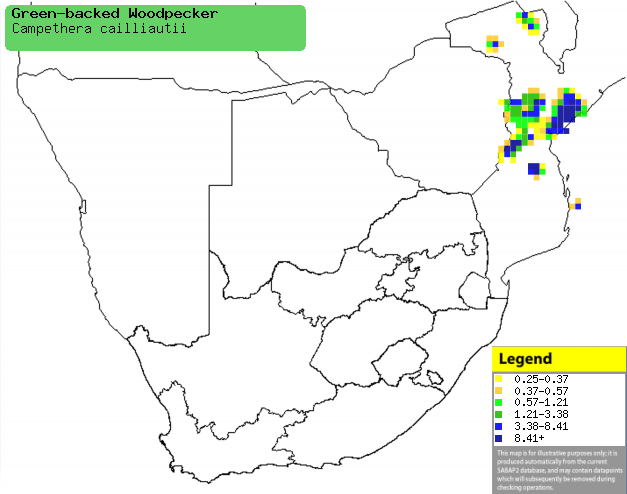|
Campethera cailliautii
(Green-backed woodpecker, Little spotted woodpecker)
Gevlekte speg [Afrikaans]; Groenrugspecht [Dutch]; Pic de
Cailliaut [French]; Tüpfelspecht [German]; Pica-pau-de-dorso-verde [Portuguese]
Life
> Eukaryotes >
Opisthokonta
> Metazoa (animals) >
Bilateria >
Deuterostomia > Chordata >
Craniata > Vertebrata (vertebrates) > Gnathostomata (jawed
vertebrates) > Teleostomi (teleost fish) > Osteichthyes (bony fish) > Class:
Sarcopterygii (lobe-finned
fish) > Stegocephalia (terrestrial
vertebrates) > Tetrapoda
(four-legged vertebrates) > Reptiliomorpha > Amniota >
Reptilia (reptiles) >
Romeriida > Diapsida > Archosauromorpha > Archosauria >
Dinosauria
(dinosaurs) > Saurischia > Theropoda (bipedal predatory dinosaurs) >
Coelurosauria > Maniraptora > Aves
(birds) > Order: Piciformes >
Family: Picidae
Distribution and habitat
Occurs from Cameroon through the DRC, Tanzania, Angola,
Zambia and Malawi to central Mozambique and eastern Zimbabwe. It generally prefers lowland and riparian
evergreen forest, as well as adjacent tall woodland with miombo (Brachystegia)
and mahabohobo (Uapaca).
|
 |
|
Distribution of Green-backed woodpecker in southern Africa,
based on statistical smoothing of the records from first SA Bird Atlas
Project (©
Animal Demography unit, University of
Cape Town; smoothing by Birgit Erni and Francesca Little). Colours range
from dark blue (most common) through to yellow (least common). |
Movements and migrations
Resident and sedentary.
Food
Exclusively eats ants (especially Crematogaster)
and termites, along with their eggs and pupae, doing most of its foraging in
the mid to upper canopy of trees. It catches prey by working its way along
branches, tapping and probing with its bill while sometimes joining mixed
species foraging flocks.
Breeding
- Monogamous and territorial, nesting solitarily in an excavated hole in the
dead branch of a tree.
- Egg-laying season is from September-February.
- It lays 2-3 eggs, which are incubated by both sexes.
- The chicks are brooded and fed by both parents, who carry the food in
their crop before regurgitating it.
Threats
Not threatened.
References
-
Hockey PAR, Dean WRJ and Ryan PG 2005. Roberts
- Birds of southern Africa, VIIth ed. The Trustees of the John Voelcker
Bird Book Fund, Cape Town.
|
